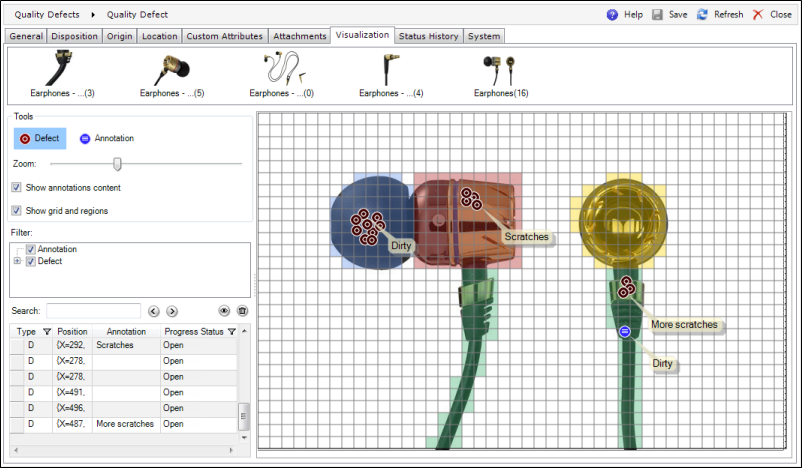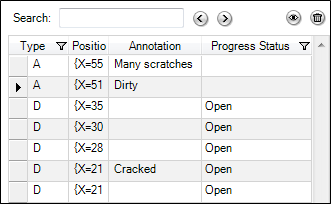
Product Images Selection Pane
This tab makes it possible to record Visual Quality Defects and Annotations in runtime. Using this functionality, a quality inspector or shop floor operator can:
Once the Visual Quality Defects have been recorded, a quality manager can calculate the concentration areas of the Visual Quality Defect occurrences using a Concentration Diagram.
Visual Quality Defect Tracking can also be defined in an Operation using the vQDT Business Control. It can then be displayed directly to the user through the DELMIA Apriso Portal, DELMIA Apriso Desktop Client or a mobile application. For more information, refer to the Quality Defects Visualization Control section of the Process Builder Help.

The images displayed on the Visualization tab are defined for the Product on the Product Maintenance screen or the Group screen (if this Product belongs to a Product Group). If images are defined for both the Product and Group then both sets are displayed here (unless the image names are the same in which case only one image will be displayed). In runtime, only images with the Active status are visible. Clicking a thumbnail will display the image and make it possible to define Visual Quality Defects and add Annotations. The number of Visual Quality Defects reported on a given image is displayed in the brackets next to its name. If the name of the image is too long to be displayed, you can hover the cursor over the image to display a tooltip with the full name. For information on how to create a Product visualization, refer to the Visual Quality Defects Tracking Implementation Guide.
If an image is removed from a Product or Product Group Visualization and Visual Defects were reported on this image, then it still will be displayed.

In the Tools panel, you can select what type of item you wish to mark
on the product image, zoom in on and out of the image, and change the
way the Annotations, regions, and grid are displayed.
To activate the Visual Quality Defect reporting mode, click  (Defect). Visual Quality
Defects can be added on the Product image to mark places where defects
were spotted on the item under inspection. When a mark is put on the image,
the system creates a new Visual Quality Defect with a given Reason Code
and links it to the Quality Defect that is being edited.
(Defect). Visual Quality
Defects can be added on the Product image to mark places where defects
were spotted on the item under inspection. When a mark is put on the image,
the system creates a new Visual Quality Defect with a given Reason Code
and links it to the Quality Defect that is being edited.
To activate the Annotation reporting mode, click  (Annotation) . Annotations are notes that can be added on the Product
image. They can be used as a source of additional information about a
given spot on the image or about a Visual Quality Defect.
(Annotation) . Annotations are notes that can be added on the Product
image. They can be used as a source of additional information about a
given spot on the image or about a Visual Quality Defect.

The filter grid enables you to change the filtering options to choose what should be displayed on the product image. Selecting the check boxes will cause the given entities to be displayed. For example, you can select only Annotations and Defects in the Open status to be displayed.
This grid displays all the Visual Quality Defects and Annotations added
to the Product image. It allows for searching for Annotations on the list
and checking where they are displayed on the Product image.
The following actions can be performed on the grid:
 (Remove)
(Remove) (Remove)
(Remove) (Find Selected) and it will be highlighted
on the image
(Find Selected) and it will be highlighted
on the imageThe grid contains the columns shown in the table below.
| Field | Description |
| Type | D=Defect, A=Annotation. |
| Position | The relative position of the Visual Quality Defect or Annotation |
| Annotation | The Annotation text
If a Visual Quality Defect does not have an Annotation added, this field will be empty. |
| Status | The Visual Quality Defect status that can be selected from
a drop-down list. The available statuses are:
The statuses do not apply to Annotations. |